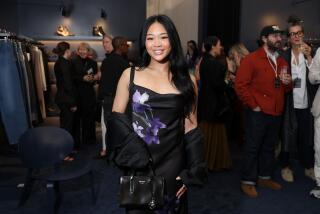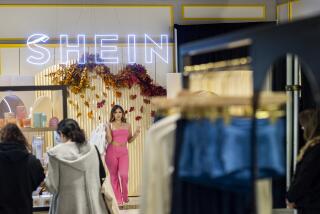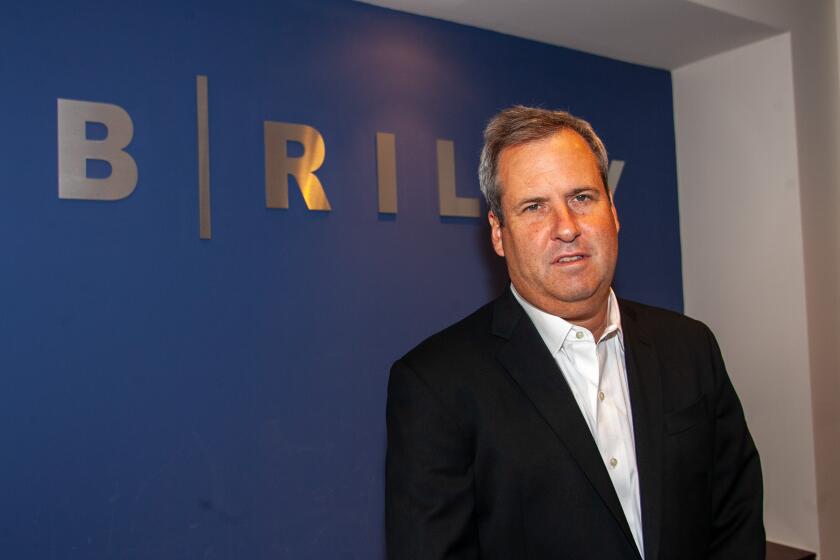With New Souson Stores, Macy’s Makes Cosmetics Changes
Macy’s newest cosmetics venture, opening today at the Topanga Plaza mall, is everything the department store’s traditional makeup areas are not: young, hip, modern, easily navigable and a mile away from the nearest Macy’s.
A bid to test ways to capture the younger customers who might not enter a Macy’s department store, Macy’s is introducing Souson, a stand-alone store identified on its signs and employee name tags as “a little something extra from Macy’s.”
Gone are the glass-enclosed cases, wrap-around counters and the heavily made-up women who traditionally stand behind them. Instead, this newest model is bringing customers open shelving, sleek display cases, small signs, just a few makeup counters (and then only in the back) and sales assistants who mingle with the customers.
Efforts to woo younger customers has become a department store preoccupation. In 1998, there were 27 million teens, a group that will grow at a faster rate than the rest of the population through 2010. Their spending will almost certainly grow as well; teenagers spent $141 billion in 1998, up 41% from 1994.
The major department stores, however, have not had the same success as their specialty-store competitors at bringing teenagers through their doors.
So in an effort to go after those free-spenders, Sears, Roebuck & Co. stores will sport in-store boutiques featuring Benetton, an Italian clothier popular among juniors and well-known by young adults. J.C. Penney Co. and Nordstrom Inc. have both announced plans to produce their own free magazines for distribution in their stores.
Macy’s parent, Federated Department Stores Inc., has indicated that a make-over of how Macy’s sells cosmetics is just the beginning.
Federated wants to make many of its departments younger, hipper and more accessible, hoping to turn juniors departments, for example, into hangouts that sell everything from CDs and nail polish to henna tattoo kits.
Cosmetics counters, especially ones that look more like those in the specialty stores many teens prefer, are a financially important place to start. Girls age 13 to 15 spend $3.08 a week on cosmetics, a figure that jumps to $10.90 once they are between 16 and 19, according to Rand Youth Poll.
Besides Souson, Macy’s has opened four experimental cosmetics departments within Macy’s stores in Escondido, Santa Ana, Newport Beach and the flagship Macy’s West store in San Francisco’s Union Square. Those in-store shops feature Souson private-label products and some of the newer brands favored by teens alongside traditional major department store cosmetics.
“The cosmetics business in a department store is a relatively mature business: There is growth there, but it is not a double-digit growth,” said Michael Steinberg, chief executive of Macy’s West. “The major arena the department store has to look at is the other customers who are not in the department store . . . the Generation Y customers.”
At the 4,500-square-foot Souson store, shoppers can choose from among some of the more traditional department-store cosmetic brands, Souson’s own lower-price cosmetics--with 150 lipstick shades at $10 each ready for testing--teen favorite Hard Candy and newer labels such as Lorac, a line from Los Angeles makeup artist Carol Shaw.
Perfumes are stationed at the sides of the store, next to a TV screen with a video loop of fragrance commercials, under such categories as “romantic,” “moderne” and “classic.” And at the Souson counters are pamphlets touting the rewards associated with the Macy’s credit card, a bid to transform those younger, non-department store shoppers into credit-card-carrying Macy’s customers for life.
Macy’s West chief Steinberg says this Souson store, as well as one that opened last month in Silicon Valley, is a place to evaluate consumer trends. Federated insists there are no plans at the moment to build more stand-alone stores.
Macy’s has a shaky history with running smaller non-Macy’s stores. In the late 1980s, before the company was bought by Federated, Macy’s opened 163 specialty stores under the names Aeropostale, for men and women, and Charter Club, a classic-clothing store for 25-to-55-year-old women. Those stores were sold off last year.
Jeff Stinson, a retail analyst with Midwest Research in Cleveland, said testing a new concept can be as much about trying out a new image as about a foray into new territory.
“It is difficult to have a material impact on the bottom line when you’re dealing with a $17-billion retailer,” Stinson said. “I think more that what they’re looking for is the type of credibility claimed by the specialty stores--they’re not just a stodgy department store but a sleek, fast-growing specialty concept.”
Wall Streeters aren’t likely to be the only ones watching and waiting.
“There are too many people who think the department-store concept is dead, and I think that’s silly. It’s only dead if we don’t re-energize and reinvigorate the thing,” Steinberg said. “Are we doing this aggressively enough? Probably not, but we need to get on with it.”
More to Read
Inside the business of entertainment
The Wide Shot brings you news, analysis and insights on everything from streaming wars to production — and what it all means for the future.
You may occasionally receive promotional content from the Los Angeles Times.










